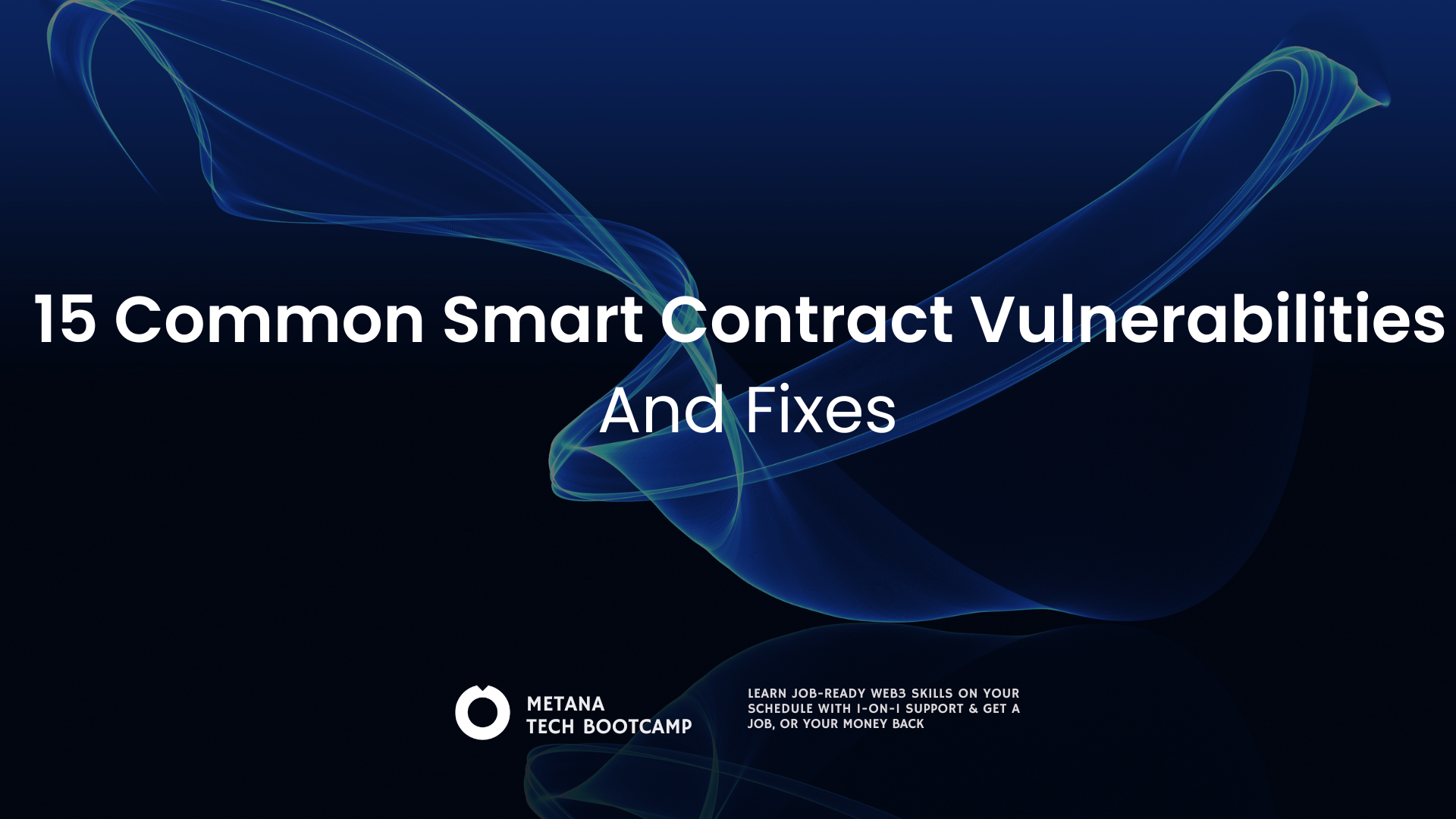TL;DR
In 2024, smart contract vulnerabilities led to over $3.5 billion in losses within the blockchain industry, underscoring the critical importance of comprehensive security audits to protect decentralized finance ecosystems. (Source: coinlaw.io)
This comprehensive guide covers the 15 most critical vulnerabilities that every developer must understand:
The Big 15:
- Reentrancy attacks – The $60M DAO hack lesson
- Flash loan manipulation – New generation attack vector
- Access control failures – Internal threats gone external
- Integer arithmetic issues – Silent fund killers
- Unchecked external calls – Dangerous assumptions
- DoS through gas manipulation – Rendering contracts unusable
- Front-running/MEV exploitation – Speed demon attacks
- Timestamp manipulation – Time traveler’s exploit
- Weak randomness – Predictable chaos
- Force-feeding Ether attacks – Unwanted gifts
- Business logic flaws – Application-specific nightmares
- Input validation failures – Garbage in, disaster out
- Delegate call dangers – Double-edged sword
- Signature replay attacks – Digital forgery
- Upgrade mechanism vulnerabilities – Evolution trap
Key Takeaways:
- Use established frameworks like OpenZeppelin
- Implement comprehensive testing and formal verification
- Conduct regular security audits ($15K-$100K is minimal vs. millions in potential losses)
- Follow security-first development practices
- Stay updated with emerging threats and defense strategies
Building secure smart contracts isn’t just about writing code—it’s about understanding the battlefield where your application will operate.
The 15 Smart Contract Vulnerabilities You Should Know
1. Reentrancy Attacks: The $60 Million Lesson That Changed Everything
Remember the DAO hack of 2016? It wasn’t just a smart contract bug. It was a wake-up call that showed the entire blockchain community how catastrophic poor security could be. The attacker exploited a reentrancy vulnerability to drain over $60 million, leading to Ethereum’s controversial hard fork.
How reentrancy works: When your contract makes an external call, it temporarily hands control to another contract. Malicious contracts can use this moment to call back into your contract before the original function completes, creating a recursive loop that bypasses your security checks.
Your defense strategy:
- Always follow the checks-effects-interactions pattern
- Update your internal state before making external calls
- Use OpenZeppelin’s ReentrancyGuard for bulletproof protection
- Consider pull-payment patterns where users initiate their own withdrawals
2. Flash Loan Manipulation: The New Generation Attack Vector
Flash loans represent one of DeFi’s most innovative feature. And one of its most dangerous. These uncollateralized loans must be repaid within the same transaction, enabling attackers to borrow massive amounts, manipulate markets, exploit price-dependent logic, and profit—all atomically.
The attack mechanism: Borrow millions in assets, manipulate decentralized exchange prices, trigger profitable interactions based on distorted prices, repay the loan, and keep the profits.
Your protection methods:
- Use time-weighted average prices (TWAP) instead of spot prices
- Implement multiple oracle sources with deviation checks
- Add circuit breakers for extreme price movements
- Consider transaction delays for large operations
3. Access Control Failures: When Internal Threats Become External Disasters
Poor access control isn’t just about unauthorized users—it’s about creating systematic vulnerabilities that attackers can exploit to gain administrative privileges. We’ve seen countless protocols fall because they treated access control as an afterthought.
Common critical mistakes:
- Using tx.origin for authentication (vulnerable to phishing attacks)
- Missing function modifiers on sensitive operations
- Incorrect role assignments that grant excessive permissions
- Failing to revoke access when roles change
Your robust solution:
- Implement OpenZeppelin’s AccessControl framework
- Use multi-signature wallets for critical operations
- Regular permission audits with automated monitoring
- Time-locks for sensitive administrative functions
4. Integer Arithmetic Vulnerabilities: The Silent Fund Killers
Before Solidity 0.8.0, arithmetic operations could silently overflow or underflow, causing balance calculations to wrap around and creating or destroying tokens without warning. Even with modern protections, understanding these vulnerabilities is crucial for secure development.
The hidden danger: Arithmetic operations that exceed type limits can cause unexpected results, allowing attackers to manipulate balances or bypass security checks through carefully crafted inputs.
Your prevention techniques:
- Use Solidity 0.8.0 or later for built-in overflow protection
- Employ SafeMath libraries for older versions
- Validate arithmetic operations, especially in financial calculations
- Implement comprehensive bounds checking for user inputs
5. Unchecked External Call Failures: The Assumption That Breaks Everything
One of the most insidious vulnerabilities occurs when contracts assume external calls will succeed. Many functions make external calls that can fail silently, causing contracts to continue execution with incorrect assumptions about the system state.
The critical problem: External calls to other contracts, token transfers, or oracle updates may fail without reverting the transaction, leaving your contract in an inconsistent state.
Your mitigation strategy:
- Always check return values from external calls
- Use OpenZeppelin’s SafeERC20 for token operations
- Implement proper error handling with meaningful revert messages
- Use try-catch blocks for non-critical external interactions
6. Denial of Service (DOS) Through Gas Manipulation
Gas-related attacks can render smart contracts completely unusable by causing them to run out of gas or become prohibitively expensive to execute. These attacks are particularly dangerous because they can be sustained over time.
Attack patterns include:
- Creating loops without gas limits
- Expensive operations in fallback functions
- Dependencies on external contracts with unpredictable gas consumption
Your defense mechanisms:
- Implement gas limits for loops and batch operations
- Use pull-over-push patterns to prevent single failures from blocking operations
- Avoid unbounded arrays and expensive operations in frequently called functions
7. Front-Running and MEV Exploitation: The Speed Demon Attacks
Front-running exploits the transparent nature of blockchain mempools, where attackers can see pending transactions and submit competing transactions with higher gas fees to be processed first. This creates an unfair advantage in trading and arbitrage opportunities.
The exploitation method: Automated bots scan the mempool for profitable transactions, then submit their own transactions with higher gas fees to capture value before the original transaction processes.
Your counter-measures:
- Implement commit-reveal schemes for sensitive operations
- Use batch auctions or Dutch auctions for fair price discovery
- Consider private mempools or meta-transactions
- Implement slippage protection and maximum gas price limits
8. Timestamp Manipulation: The Time Traveler’s Exploit
Smart contracts that rely on block.timestamp for critical logic are vulnerable to minor manipulation by miners. While the manipulation window is small (typically 15 seconds), it’s enough to influence auctions, rewards, or time-locked functions.
The vulnerability window: Miners can adjust timestamps within reasonable bounds to influence contract execution in their favor, affecting time-dependent mechanisms.
Your secure alternatives:
- Use block numbers for time-based logic where possible
- Implement reasonable tolerance windows for timestamp-dependent operations
- Consider commit-reveal schemes for time-sensitive auctions
9. Weak Randomness Generation: The Predictable Chaos
Generating truly random numbers on a deterministic blockchain is challenging. Many contracts use predictable sources like block hashes or timestamps, allowing attackers to predict and exploit random outcomes. Also, called as insecure randomness in smart contracts.
The fundamental challenge: Blockchain environments are deterministic by design, making traditional randomness sources predictable to attackers who can manipulate or predict these sources.
Your solutions:
- Use verifiable random functions (VRFs) like Chainlink VRF
- Implement commit-reveal schemes with user-provided entropy
- Combine multiple randomness sources for increased security
- Never use block.timestamp or block.difficulty alone for randomness
10. Force-Feeding Ether Attacks: The Unwanted Gift
Attackers can force contracts to receive Ether through methods like selfdestruct, potentially breaking logic that depends on balance checks. This can bypass security mechanisms that rely on contract balance for access control.
The attack mechanism: The selfdestruct function can send Ether to any address, including contracts without payable functions, inflating contract balances unexpectedly.
Your defense strategy:
- Never rely on contract balance for access control or business logic
- Use internal accounting variables instead of address(this).balance
- Implement proper balance tracking through internal state variables
11. Business Logic Flaws: The Application-Specific Nightmares
Complex smart contracts often contain subtle logic errors that don’t manifest as technical vulnerabilities but can be exploited to extract value or manipulate contract behavior in unintended ways.
The unique challenge: Business logic errors are application-specific and difficult to detect with automated tools. They often involve complex interactions between multiple functions or contracts.
Your prevention approach:
- Implement comprehensive testing including edge cases and adversarial scenarios
- Use formal verification for critical functions
- Conduct thorough security audits with business logic focus
- Implement gradual rollouts with extensive monitoring
12. Input Validation Failures: The Garbage In, Disaster Out Problem
Insufficient input validation can lead to unexpected behavior, crashes, or exploitation. This fundamental programming principle becomes critical in the immutable world of smart contracts.
Common dangerous oversights:
- Not validating address parameters for zero addresses
- Missing bounds checks on array indices
- Accepting invalid enum values
- Not validating function parameters against business rules
Your validation framework:
- Implement comprehensive input validation at function entry points
- Use require statements with descriptive error messages
- Validate all parameters against expected ranges and constraints
- Consider using input validation libraries for common patterns
13. Delegate Call Dangers: The Double-Edged Sword
Delegate calls execute external code in the caller’s context, potentially allowing attackers to modify contract state or access sensitive data. While powerful, improper use can lead to complete contract takeover.
The critical risk: Delegate calls preserve the caller’s storage layout and permissions, making them extremely powerful but dangerous if used with untrusted contracts.
Your safe usage patterns:
- Only use delegate calls with trusted, immutable contracts
- Implement strict access controls around delegate call functions
- Consider using libraries instead of delegate calls where possible
- Validate the target contract before making delegate calls
14. Signature Replay Attacks: The Digital Forgery Exploit
Digital signatures can be replayed across different contexts if not properly protected, allowing attackers to execute transactions multiple times or in unintended contexts.
The replay problem: Without proper nonce management or domain separation, valid signatures can be reused by attackers to execute unauthorized transactions.
Your protection mechanisms:
- Implement nonce-based replay protection
- Use domain separation with chain ID and contract address
- Include expiration times in signed messages
- Implement comprehensive signature verification with all necessary checks
15. Upgrade Mechanism Vulnerabilities: The Evolution Trap
Upgradeable contracts introduce additional attack vectors through their upgrade mechanisms. Malicious upgrades can completely compromise contract security, while improper upgrade procedures can lock funds permanently.
The upgrade risks:
- Centralized upgrade controls without proper governance
- Missing upgrade delays that allow immediate malicious changes
- Incompatible storage layouts that corrupt contract state
- Lack of community governance in upgrade decisions
Your secure upgrade patterns:
- Use OpenZeppelin’s upgrade patterns with proper storage layout management
- Implement time-locked upgrades with community governance
- Use transparent proxy patterns to separate logic from data
- Conduct thorough testing of upgrade procedures
Building Your Security-First Development Process
🛡️ Security-First Development Lifecycle
+ ╔══════════════════════════════════════════════════════════════╗
+ ║ 🎯 1. Design Phase │ Use proven frameworks (OpenZeppelin) ║
+ ║ 💻 2. Development │ Implement secure coding patterns ║
+ ║ 🧪 3. Testing Phase │ Unit + Integration + Fuzzing tests ║
+ ║ 🔍 4. Audit Phase │ Internal + External security audits ║
+ ║ 🚀 5. Deployment │ Gradual rollout with monitoring ║
+ ║ 🔧 6. Maintenance │ Bug bounties + ongoing monitoring ║
+ ╚══════════════════════════════════════════════════════════════╝Securing smart contracts requires more than just avoiding vulnerabilities—it requires a comprehensive approach that makes security a core part of your development process.
Start with Proven Frameworks
Don’t reinvent the wheel. Use established frameworks like OpenZeppelin that have been battle-tested by thousands of developers and audited by security experts. These libraries provide secure implementations of common patterns and significantly reduce your attack surface.
Implement Comprehensive Testing
Your testing strategy should include:
- Unit tests for individual functions
- Integration tests for complex interactions
- Fuzzing to discover edge cases
- Formal verification for critical functions
- Adversarial testing with attack scenarios
Conduct Regular Security Audits
Security audits aren’t just a checkbox—they’re an essential part of responsible development. Plan for multiple audit rounds, including:
- Internal security reviews
- External security audits from reputable firms
- Bug bounty programs for ongoing security assessment
- Post-deployment monitoring and incident response
When budgeting for smart contract security, remember that prevention is always cheaper than remediation. A comprehensive security audit might cost $15,000-$100,000, but a single vulnerability can cost millions in lost funds and reputation damage.
Finally… Smart Contract Security
Security isn’t a destination—it’s a journey. The blockchain ecosystem evolves rapidly, and new vulnerabilities emerge constantly. Stay ahead by:
- Continuously educating yourself about new attack patterns and defense strategies
- Participating in the security community through bug bounty programs and security research
- Learning from real-world attacks by studying post-mortem reports
- Implementing ongoing monitoring to detect potential issues after deployment
The blockchain revolution depends on developers like you who take security seriously. Start implementing these practices today, and help build a more secure decentralized future.The blockchain revolution depends on developers like you who take security seriously. Start implementing these practices today, and help build a more secure decentralized future.
Frequently Asked Questions
Q: What’s the most dangerous smart contract vulnerability for DeFi protocols?
A: Reentrancy attacks combined with flash loan manipulation pose the greatest threat to DeFi protocols. These vulnerabilities can be chained together to drain entire protocols in a single transaction, as demonstrated by attacks like the DAO hack and numerous recent DeFi exploits. The combination allows attackers to borrow large amounts, exploit reentrancy vulnerabilities, and repay loans atomically, making detection and prevention extremely challenging.
Q: How much should I budget for smart contract security audits?
A: Security audit costs vary based on contract complexity, but expect $15,000-$100,000 for comprehensive audits from reputable firms. However, this investment is minimal compared to potential losses from vulnerabilities. For context, the Cetus hack resulted in $223 million in losses, while the Penpie attack cost $27 million. Many projects also implement bug bounty programs offering $10,000-$1 million rewards for critical vulnerability discoveries.
Q: Can automated tools replace manual security audits?
A: No, automated tools are essential but insufficient alone. While tools like Slither, Mythril, and Securify can detect many technical vulnerabilities, they miss business logic errors, complex attack patterns, and contextual security issues. The most effective approach combines automated scanning with manual expert review, formal verification for critical functions, and ongoing monitoring. Business logic flaws, which represent a significant portion of real-world exploits, require human expertise to identify and resolve.
Additional Resources
For developers looking to deepen their smart contract security knowledge, consider exploring Metana’s Smart Contract Development Course which covers advanced security patterns and best practices.








